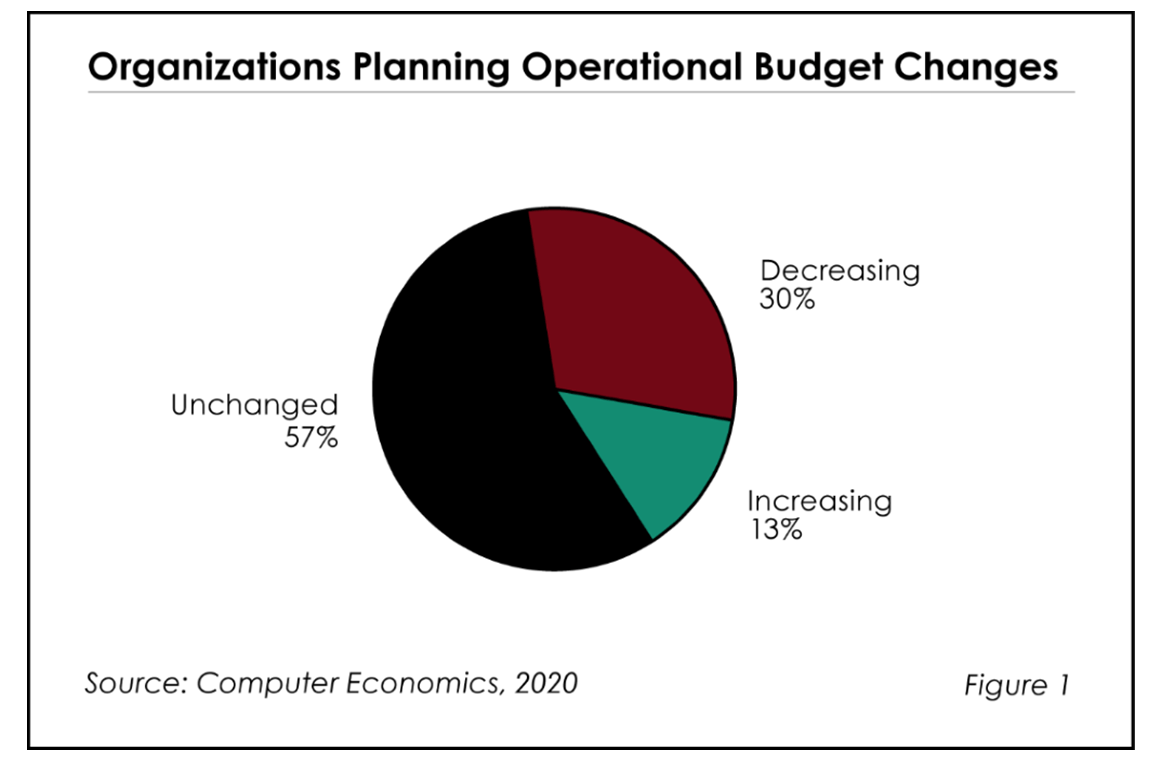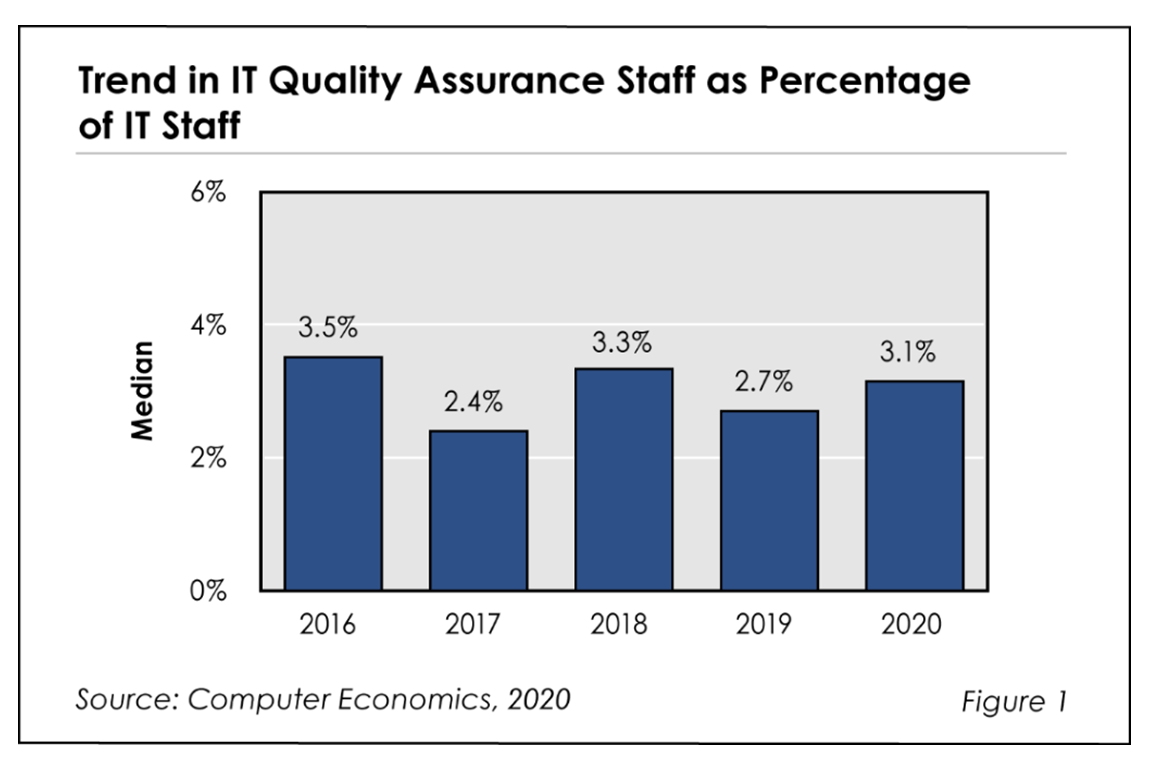Latest Reports
-
![The Impact of COVID-19 on IT Budgets in 2020 Fig1ImpactofCOVID19 - The Impact of COVID-19 on IT Budgets in 2020]()
The Impact of COVID-19 on IT Budgets in 2020
The coronavirus pandemic of 2020 has led to a worldwide recession, with a significant impact on IT budgets. Because our current IT spending benchmarks adjust based on levels of business activity, they can still be applied in times of economic decline. Nevertheless, many IT leaders want to understand how IT spending is being influenced by current pandemic and economic conditions. Based on our special survey, this report outlines how the pandemic is affecting IT operational budgets, IT capital budgets, IT staff head counts, compensation, outsourcing, budgets for new projects, and the use of the public cloud.
July, 2020
-
![User-Satisfaction Surveys and IT Performance Metrics Adoption and Best Practices 2019 Fig3UserSatisfactionPerformance2019 - User-Satisfaction Surveys and IT Performance Metrics Adoption and Best Practices 2019]()
User-Satisfaction Surveys and IT Performance Metrics Adoption and Best Practices 2019
Periodic surveys of user satisfaction are one way to measure how well an IT organization is delivering services, resolving issues, and managing perceptions. If user satisfaction is falling, it may mean that the service desk is understaffed or change requests are not being accommodated. At the same time, collecting data on service levels can be useful for tracking and monitoring performance in a service organization. But taking the next step and publishing the performance metrics for the community can be even more useful. In this report, we look at the maturity of surveying user satisfaction and publishing IT performance metrics.
July, 2019
-
![Post Event Graphic for 10-20-20 event Executives from Avasant, IDB, and EBRD as they discuss Transforming Global Organizations in a Borderless World]()
Transforming Global Organizations in a Borderless World: Enabling Digital Innovation and Operational Excellence
We are living in unprecedented times. While the digital economy was growing at a rapid pace the coronavirus pandemic (Covid-19) has forced us into unchartered territories almost overnight. The process of digitalization was already underway, but this crisis has accelerated that transformation and enabled virtual and digital workplaces
October, 2020
-
![African Market Trends in Technology Services Africa - African Market Trends in Technology Services]()
African Market Trends in Technology Services
Few studies examine information technology and business process management in Africa. This report, based on research and interviews, analyses the tech sectors of 11 African countries and examines enabling factors such as information and communication technology infrastructure, government incentives and the regulatory environment. One key finding is that trade and retail, financial services, healthcare and agriculture offer the most opportunities for tech firms. This publication shares insights that will guide companies interested in offering information technology and business process outsourcing services in Africa. The report is also valuable for stakeholders, including tech hubs and start-ups, investors and government organizations.
November, 2020
-
![Nobody Loves Two-Factor Authentication Fig3TwoFactorAdoptionAndBestPractices - Nobody Loves Two-Factor Authentication]()
Nobody Loves Two-Factor Authentication
Two-factor authentication (2FA) is an IT security best practice that provides an extra layer of protection for system access, by asking a user for a second means of identification. It mitigates risk of unauthorized access and yet, despite these benefits, our annual survey of IT management best practices shows that too few companies apply two-factor authentication formally and consistently. This Research Byte explores some reasons for the lukewarm adoption of 2FA.
February, 2020
-
![COVID-19: Enterprise Resilience Is Tested Like Never Before Covid - COVID-19: Enterprise Resilience Is Tested Like Never Before]()
COVID-19: Enterprise Resilience Is Tested Like Never Before
With the ongoing pandemic many stories emerged of resilience, responsiveness, and innovation, as many of us are forced to live in the future. People were asked to act against their nature and shift from a collaborative workplace environment to isolation at home, further blurring the lines between work and life. This led to a need to strengthen the digital muscle hinged around remote-first working, cloud acceleration, smart IT operations, and automated business operations. Infosys seems to have already laid down the digital rail tracks which helped boost revenue and profit, reflecting resilience and adaptability of its business model in this time of crisis.
October, 2020
-
![Transforming the Enterprise: Driving Digital Innovation Through Hybrid Cloud products for post events hybrid cloud netaoo - Transforming the Enterprise: Driving Digital Innovation Through Hybrid Cloud]()
Transforming the Enterprise: Driving Digital Innovation Through Hybrid Cloud
As enterprises accelerate their digital transformation journey, Hybrid Cloud environments have become the platform for agility, innovation, high-performance computing, enterprise applications, data analytics, and automating data services.
October, 2020
-
![IT Asset Management Adoption Grows, Despite Complicating Factors Fig3ITAssetManagementBestPractice - IT Asset Management Adoption Grows, Despite Complicating Factors]()
IT Asset Management Adoption Grows, Despite Complicating Factors
For IT organizations, the dream of having all IT assets fully documented and tracked within a formal system remains elusive. While IT organizations have been able to bring certain assets under control, as soon as one area has stabilized, the technology changes. Employee-owned devices and technologies designed to simplify IT asset management such as SaaS keep moving the goal line. This Research Byte provides a summary of our full report on IT asset management adoption and best practices.
August, 2019
-
![Avasant Digital Forum: Securing The Enterprise In The Post Covid World: Next Generation Cyber Defense cybersecurity product image - Avasant Digital Forum: Securing The Enterprise In The Post Covid World: Next Generation Cyber Defense]()
Avasant Digital Forum: Securing The Enterprise In The Post Covid World: Next Generation Cyber Defense
As enterprises rapidly shift to Cloud, Agile and Edge computing, their cyber security strategy has to adapt. The pandemic has further escalated the cyber-risks as organizations shifted to Work from Home and virtualized their operations. The Post-COVID enterprise security strategies must include a Cloud-centric model that spans across the extended work boundaries and a hybrid/multi-cloud environment. Securing your data against cyber threats and ransomware in this Extended Enterprise is now one of the most critical priorities.
December, 2020
-
![Coronavirus Impact on IT Budgets Still Coming Fig1ImpactofCOVID19 - Coronavirus Impact on IT Budgets Still Coming]()
Coronavirus Impact on IT Budgets Still Coming
Benchmarking IT spending and staffing is a complicated task in the best of economic conditions. Benchmarking in the middle of a global pandemic and recession is even more difficult, but also more important. As we prepare the launch of the 31st edition of our annual IT Spending and Staffing Benchmarks report, this is the challenge.
July, 2020
-
![QA Staffing and the Changing Nature of Software Development QAstaffing2020Fig1 - QA Staffing and the Changing Nature of Software Development]()
QA Staffing and the Changing Nature of Software Development
IT quality assurance has always been a small but vital role in IT organizations. However, the role of quality assurance as a discrete job position is in a state of flux. The changing nature of software development is a big influence in QA staffing. This Research Byte examines the reasons for the trend and provides a summary of our full report on IT quality assurance staffing ratios.
October, 2020
-
![Data Management Staffing Ratios 2020 Fig1DataMgtStaffingratio2020 - Data Management Staffing Ratios 2020]()
Data Management Staffing Ratios 2020
The data explosion is finally making an impact on data management staffing. Through the middle of the decade, data management staffing plateaued despite the fact that organizations of all sizes were making more use of data. However, data management head count recently has increased significantly. In this study, we use four benchmarks to assess data management staffing levels: data management staff as a percentage of the IT staff, data management staff as a percentage of the Application Group, users per data management staff member, and applications per data management staff member. (21 pp., 10 fig.)
September, 2020


















